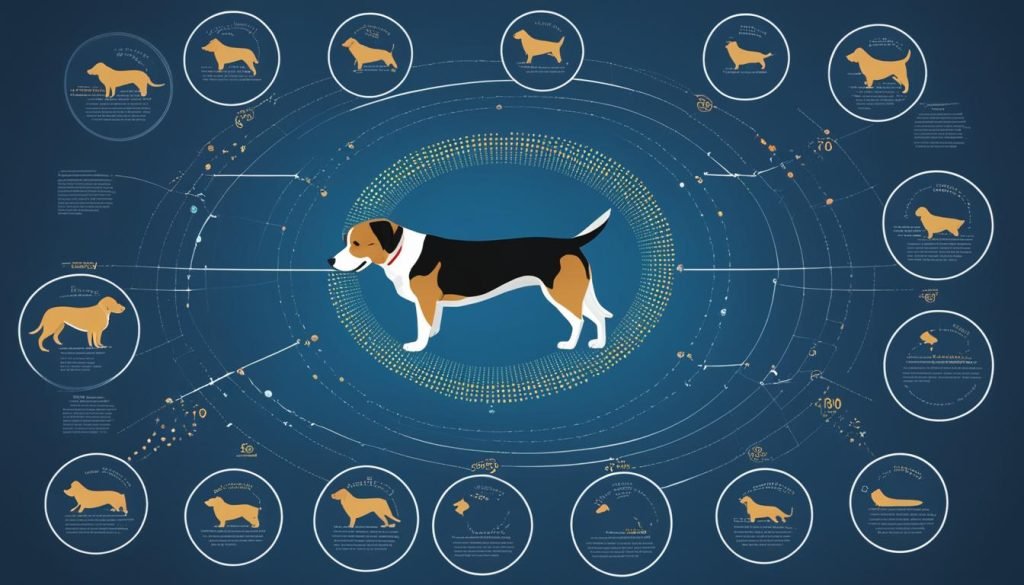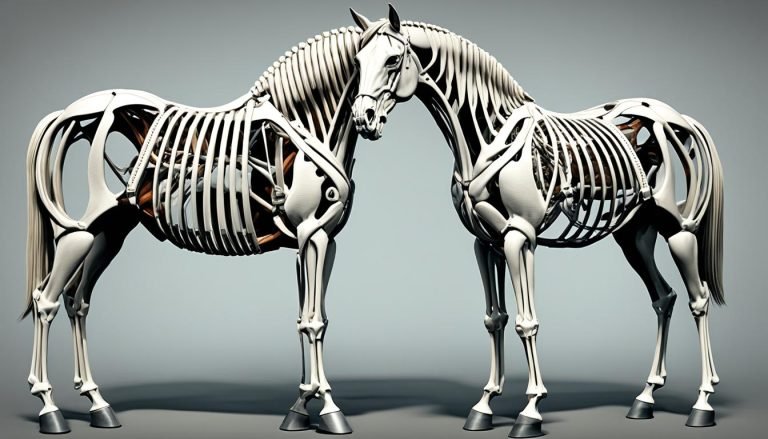Dog Pregnancy Duration: How Long Are Dogs Pregnant?
Are you curious about how long dogs are pregnant? Understanding the timeline of dog pregnancy, also known as the gestation period, is essential for dog breeders and pet owners alike. While the duration of dog pregnancy may vary, there are key stages and milestones to be aware of.
Dogs have a relatively shorter gestation period compared to humans. Female dogs typically go into heat, or estrus, every six months, with each heat cycle lasting between 18 to 21 days. This heat cycle is further divided into four stages: proestrus, estrus, diestrus, and anestrus. Breeders use these stages to determine the best time to breed their dogs and accurately predict the conception dates to test for pregnancy.
Key Takeaways:
- The gestation period in dogs is shorter than in humans
- Female dogs go into heat every six months, with each heat cycle lasting 18-21 days
- The heat cycle is divided into four stages: proestrus, estrus, diestrus, and anestrus
- Breeders use these stages to determine the best time to breed their dogs
- Understanding the timeline of dog pregnancy is crucial for accurate pregnancy testing and optimal care
The Reproductive Cycle in Dogs

Understanding the reproductive cycle in dogs is crucial for breeders and pet owners alike. Female dogs, also known as bitches, go through a heat cycle approximately every six months, with each cycle lasting an average of 18 to 21 days.
The heat cycle in dogs is divided into four distinct stages: proestrus, estrus, diestrus, and anestrus. Each stage plays a vital role in the reproductive process and is characterized by specific physical and hormonal changes.
Proestrus:
The first stage of the heat cycle is proestrus. During this phase, which typically lasts around 9 days, the bitch’s vulva swells, and she may experience a bloody discharge. This stage is considered the preparatory phase for potential mating, but the female is not yet fully receptive to the male.
Estrus:
Estrus is the second stage of the heat cycle and is often referred to as the “standing heat” phase. It occurs after proestrus and lasts roughly 9 days. During this time, the bitch becomes sexually receptive to the male. Her vulva returns to its normal size, and the bloody discharge transitions to a lighter color or stops altogether.
Diestrus:
Diestrus is the third stage of the heat cycle and begins immediately after estrus. It typically lasts around 2 months, regardless of whether the bitch becomes pregnant or not. During diestrus, the female’s reproductive system prepares for pregnancy, and if conception occurs, the embryos will implant in the uterine lining. However, if fertilization does not take place, the body undergoes natural hormonal changes to return the reproductive system to a non-receptive state.
Anestrus:
Anestrus is the fourth and final stage of the reproductive cycle. It is a period of sexual quiescence that occurs between one heat cycle and the next. Anestrus lasts approximately six months and is characterized by low hormone levels and no signs of heat or fertility.
This rhythmic cycle of proestrus, estrus, diestrus, and anestrus repeats throughout the bitch’s reproductive life unless she is spayed or experiences certain medical conditions.
Understanding the stages of the reproductive cycle in dogs is essential for managing breeding programs or simply taking proper care of a pet. By recognizing the signs and changes that occur during each stage, dog owners can provide appropriate care and make informed breeding decisions.
How to Tell if a Dog Is Pregnant

Determining whether a dog is pregnant can be a challenge. However, there are several methods that veterinarians use to confirm pregnancy in dogs. These methods include:
- Hormone tests: Hormone tests can detect the presence of relaxin, a hormone that is only produced during pregnancy. This test can provide an accurate confirmation of pregnancy.
- Palpation: Palpation involves gently feeling the dog’s abdomen between days 21 and 35 of gestation. By doing so, veterinarians can detect the growing sacs and determine if the dog is pregnant.
- X-ray: X-ray can be performed after day 55 of gestation to count the number of expected puppies. This method helps to estimate the size of the litter and prepare for the upcoming whelping process.
- Ultrasound: Ultrasound is the most effective method of detecting early pregnancy and determining the fetal heartbeat. This non-invasive procedure allows veterinarians to visualize the developing puppies and monitor their growth.
Using one or a combination of these methods, veterinarians can accurately confirm if a dog is pregnant. Each method has its own advantages and is suitable for different stages of pregnancy. For early detection and monitoring, ultrasound is the preferred choice.
“Determining whether a dog is pregnant can be a challenge, but veterinarians have various methods at their disposal to accurately confirm pregnancy.” – Dr. Sarah Thompson, Veterinarian
Knowing if your dog is pregnant is essential for proper care and preparation. Whether the pregnancy is planned or unexpected, it is important to provide the necessary healthcare and support for the expecting mother and her puppies.
| Method | Accuracy | Best Time to Perform |
|---|---|---|
| Hormone tests | High | After 25 days of gestation |
| Palpation | Moderate | Between days 21 and 35 of gestation |
| X-ray | High | After day 55 of gestation |
| Ultrasound | High | Throughout pregnancy, starting from day 25 |
Gestation Period: How Long Are Dogs Pregnant?
The gestation period in dogs is a crucial time for the development of the puppies. While the average gestation period is approximately 63 days from conception, it can vary depending on various factors such as sperm longevity and egg fertility.
Sperm can survive inside the female dog’s reproductive system for several days, waiting for the eggs to be released. Once the eggs are released, they remain fertile for up to 48 hours. This makes it challenging to accurately predict the exact length of pregnancy without veterinary assistance.
Hormone measurements provide a more precise estimation of the gestation period. Typically, the gestation period ranges from 56 to 58 days from the first day of diestrus to 58 to 72 days from the first time the bitch allowed breeding.
To give you a better understanding of the potential range, here is a table that illustrates the average duration of dog pregnancy based on the different stages:
| Stage of Pregnancy | Duration |
|---|---|
| The first day of diestrus to the first time the bitch allowed breeding | 56-58 days |
| First day of diestrus to gestation completion | 58-72 days |
It’s important to note that these timeframes are approximate and can vary from dog to dog. Consulting with a veterinarian is essential to monitor the progression of the pregnancy and ensure the health and well-being of both the mother and the puppies.
Stages of Dog Pregnancy
Dog pregnancy progresses through three stages, each marked by significant changes in the developing embryos. Understanding these stages can help dog owners and breeders monitor the pregnancy and ensure the well-being of the mother and puppies.
First Month: Embryo Development
During the first month of dog pregnancy, the embryos travel to the uterine horns, where they implant and begin to develop. By day 28 or 30, the heartbeat of the fetus can be detected using an ultrasound. This is an exciting milestone as it confirms the presence of viable embryos.
Second Month: Rapid Fetal Development
In the second month, the puppies undergo rapid development. Their coat, skeletons, and claws start to form, and their size increases significantly. The bitch’s belly becomes larger, and she may experience behavioral changes and weight gain due to the growing fetus.
Third Month: Final Preparation for Birth
In the third and final month of dog pregnancy, the puppies are fully developed and ready to be born. They move into position in the birth canal, getting ready for the birthing process. During this time, the bitch may exhibit signs of restlessness and decreased appetite, indicating that labor may soon begin.
It is crucial to provide the mother dog with proper care, nutrition, and a safe environment during each stage of pregnancy to ensure the health and well-being of both the mother and the puppies.
How Long Are Dogs in Labor?

Labor in dogs occurs after the gestation period. It is a crucial process that brings new life into the world. Understanding the duration and stages of dog labor is essential for every dog owner and breeder. Let’s explore the different stages of dog labor and how long each stage typically lasts.
Stage One: Early Labor
The first stage of labor, known as early labor, is characterized by the onset of contractions. During this stage, the cervix begins to dilate, preparing for the delivery of the puppies. These mild contractions gradually increase in strength and frequency. It is important to note that stage one of labor can last quite a while, typically lasting between 12 to 24 hours.
Stage Two: Active Labor
Once stage one is complete and the cervix is fully dilated, the active labor stage begins. This is the stage where the puppies are delivered. Each puppy is born in a separate amniotic sac and is usually delivered within 1 to 2 hours of active labor. The mother dog will have strong contractions during this stage to facilitate the delivery of each puppy. It is crucial to provide a calm and supportive environment for the mother during this stage to ensure a smooth delivery.
Stage Three: Placenta Delivery
The final stage of dog labor is the delivery of the placenta. After each puppy is born, the mother will expel the placenta, which is the organ that nourishes and sustains the puppies during their time in the womb. The delivery of each placenta should occur within a short time after each puppy’s birth. It is important to ensure that all placentas are delivered, as retained placentas can lead to complications.
It is worth noting that the duration of dog labor can vary. While these timeframes are typical, every dog is unique, and it is essential to monitor the labor closely. If labor exceeds 24 hours or there are long gaps between puppy deliveries, it is crucial to seek veterinary assistance.
| Stage of Labor | Duration |
|---|---|
| Stage One: Early Labor | 12 to 24 hours |
| Stage Two: Active Labor (per puppy) | 1 to 2 hours |
| Stage Three: Placenta Delivery | Short time after each puppy’s birth |
Taking the Next Step
Proper care is crucial during dog pregnancy. As a responsible dog owner, it’s important to prioritize the well-being of your pregnant dog and prepare for the arrival of her puppies.
One of the key aspects of caring for a pregnant dog is nutrition. Providing a balanced and nutritious diet is vital to support the health of both the mother and her growing puppies. Consult with your veterinarian to determine the appropriate type and amount of food for your pregnant dog. Feeding high-quality puppy food is often recommended as it contains the essential nutrients needed during this critical period.
In addition to proper nutrition, regular veterinary care is essential for a healthy dog pregnancy. Schedule regular check-ups with your veterinarian to monitor the progress of the pregnancy, address any concerns, and ensure the overall health of the mother dog. Vaccinations, parasite prevention, and any necessary medical treatments should be discussed and administered under the guidance of a veterinarian.
To prepare for the upcoming birth, it’s important to create a suitable whelping area for the mother dog. Choose a warm, quiet, and clean space where she can comfortably deliver and nurse her puppies. Provide clean bedding and ensure the area is secure to prevent any potential hazards.
It is also beneficial to educate yourself on proper newborn puppy care. Understanding how to handle and care for newborn puppies can help ensure their health and well-being. Topics such as temperature regulation, feeding, and stimulating elimination are important aspects of newborn puppy care.
By taking the necessary steps to provide proper nutrition and veterinary care, and preparing for the arrival of the puppies, you can help ensure a healthy and successful dog pregnancy.
Key Points:
- Care for your pregnant dog by providing proper nutrition with high-quality puppy food recommended by your veterinarian.
- Schedule regular veterinary check-ups to monitor the mother’s health and address any concerns.
- Create a suitable whelping area that is warm, quiet, and clean for the upcoming birth.
- Educate yourself on proper newborn puppy care to ensure their health and well-being.
Fertilization and Embryo Development in Dogs

Fertilization in dogs occurs when the female’s eggs are fertilized by male sperm. This process typically happens during the female’s heat cycle, specifically during the estrus stage when she is receptive to mating. The male’s sperm travels through the female’s reproductive tract and reaches the eggs in her fallopian tubes. Once fertilized, the embryos begin their journey toward implantation in the uterus.
Embryo development in dogs is a fascinating and intricate process. After fertilization, the embryos migrate from the fallopian tubes to the uterine horns, where they attach themselves to the lining of the uterus. This implantation occurs around days 17-20 of gestation.
As the embryos continue to develop, important milestones are reached. By day 25-28, their growth becomes more evident, and a veterinarian can feel the growing embryos through palpation. Using ultrasound, heartbeats can also be detected at this stage, providing reassurance of a healthy pregnancy.
It is crucial to note that embryo migration in dogs is an essential part of their development. The embryos must navigate through the female’s reproductive tract before reaching the uterus. This journey is a delicate process that can take several days. Any disruption or delay in migration can potentially affect the development and viability of the embryos.
The embryo development stage continues, and by day 35, the embryos transition into the fetus stage. At this point, the fetal structures are well-formed, and their growth and maturation will continue until birth.
Maintaining a Healthy Pregnancy in Dogs
During the early stages of gestation, it is important to focus on maintaining your dog’s ideal weight. Excessive weight gain can lead to complications during pregnancy and delivery. The recommended weight gain for pregnant dogs should not exceed 10% of their ideal weight during the first 42 days.
Proper weight management is crucial to ensure a healthy pregnancy for your dog.
During the initial phase of pregnancy, the dog’s energy requirements remain stable, and no significant changes in nutrition are usually necessary. However, as the pregnancy progresses, the dog’s nutritional needs change, requiring adjustments to their diet.
Consulting with a veterinarian is essential to determine the specific dietary recommendations for your pregnant dog. They can guide in choosing a diet with higher energy, protein, and mineral content to support the developing puppies and the mother’s health.
A well-balanced and nutrient-rich diet is crucial for the overall well-being of a pregnant dog.
In addition to a well-rounded diet, some pregnant dogs may benefit from the supplementation of certain nutrients. Dog pregnancy supplements can help ensure that both the mother and the developing puppies receive adequate vitamins and minerals.
Supplements tailored for dog pregnancy can provide the necessary nutritional support.
Benefits of Dog Pregnancy Supplements
Dog pregnancy supplements are specifically formulated to meet the increased nutritional requirements of pregnant dogs. They can provide various benefits, including:
- Enhanced fetal development
- Improved immune function
- Increased milk production
- Optimal maternal health
| Benefits of Dog Pregnancy Supplements | Description |
|---|---|
| Enhanced fetal development | Provide essential nutrients for the healthy growth and development of the puppies. |
| Improved immune function | Support the mother’s immune system, which indirectly benefits the developing puppies. |
| Increased milk production | Ensure the mother has an adequate supply of milk to nourish the puppies after birth. |
| Optimal maternal health | Promote the overall well-being of the mother during pregnancy and postpartum. |
Preparing for Whelping in Dogs
Preparing for the whelping process is essential to ensure a smooth and safe delivery for your pregnant dog. By creating a comfortable and suitable whelping area, monitoring the dog’s temperature, and being aware of the signs of impending labor, you can help ensure a positive birthing experience.
Choosing the Whelping Area
When preparing for whelping, it is important to choose a quiet and warm area in your house for the mother dog. The room should be easily accessible and have enough space for the dog to move around comfortably. It is also crucial to make sure the area is easy to clean and sanitize to maintain proper hygiene.
Providing clean bedding is essential to keep the whelping area comfortable and free from infections. Soft and absorbent materials, such as old blankets or towels, should be used. These can be easily replaced as needed during the whelping process.
Monitoring Temperature and Signs of Impending Labor
Monitoring your pregnant dog’s temperature is a useful way to predict when labor is approaching. A normal dog’s temperature is around 101-102.5°F (38.3-39.2°C). In the last 24 hours before labor begins, the temperature can drop to below 99°F (37.2°C). Once you notice this drop, prepare for the imminent arrival of the puppies.
Observing your dog’s behavior and nesting habits can also provide clues that labor is approaching. Many pregnant dogs exhibit nesting behavior, where they create a comfortable space for themselves and the upcoming puppies. This can include digging in bedding or seeking out secluded areas. Keep an eye out for any changes in behavior and nesting activity as signs of impending labor.
Visualizing the Whelping Area
To help you visualize the ideal whelping area setup, here is a table summarizing the key considerations:
| Whelping Area | Details |
|---|---|
| Location | Choose a quiet and warm area in your house |
| Space | Ensure enough room for the dog to move comfortably |
| Cleanliness | Select an area that is easy to clean and sanitize |
| Bedding | Provide clean and soft blankets or towels |
| Temperature Monitoring | Regularly check your dog’s temperature |
| Signs of Impending Labor | Observe nesting behavior and changes in behavior |
By preparing a suitable whelping area, monitoring temperature changes, and staying attentive to your dog’s behavior, you can ensure a safe and comfortable environment for the whelping process. Providing proper care and attention during this crucial time will contribute to the well-being of the mother dog and the successful delivery of the puppies.
Puppy Development in the Womb
Puppy development in the womb is a fascinating and intricate process. Throughout the gestation period, puppies go through various milestones that signify their growth and preparations for life outside the womb. Let’s take a closer look at the key developmental stages.
Day 45: First Hairs and Ossification
By day 45 of pregnancy, the puppies’ first hairs start to appear, giving them a furry appearance. This signifies their transition from the embryonic to the fetal stage. Additionally, their skeletons begin to ossify, or harden, as their bones develop.
Day 50: Counting the Puppies
At around day 50, an x-ray can be performed to count the number of puppies in the litter. This is especially useful for breeders to have an accurate estimate of litter size and prepare accordingly. The x-ray allows visualization of the puppies’ skeletons, enabling an accurate count.
Third Month: Fully Developed and Preparing for Birth
By the start of the third month, the puppies are fully developed and ready to enter the world. They have completed their growth and development, and their organs and systems are fully functional. The puppies begin to move into the birth canal as they position themselves for the upcoming delivery.
Whelping and the Birth of Puppies
Whelping is the natural process through which dogs give birth to their puppies. It is a remarkable event that involves three distinct stages. In the first stage, contractions gradually increase in strength and frequency as the mother’s body prepares for labor. This stage can last several hours, and it is essential to monitor the progress closely. The mother may exhibit signs of restlessness, panting, and nesting behavior.
The second stage is the actual delivery of the puppies. Each puppy is born individually and can take anywhere from a few minutes to an hour to be delivered. The mother will instinctively clean the puppies and sever the umbilical cord. It is crucial to provide a quiet and stress-free environment to facilitate the birthing process.
The third stage involves the expulsion of the placenta, the organ that nourishes the puppies during their time in the womb. The mother will typically consume the placenta, which provides important nutrients and helps stimulate milk production. While it is normal for the mother to eat the placenta, excessive consumption or issues during this stage should be monitored and reported to a veterinarian.
During the whelping process, it is crucial to maintain an appropriate temperature for the newborn puppies. The ideal temperature for newborn puppies is around 85-90°F to ensure their comfort and survival. Additionally, it is essential to provide the mother and her puppies with proper care and attention. This includes keeping the whelping area clean, providing a suitable nesting space, and ensuring the mother receives a nutritious diet to support milk production. Regular veterinary check-ups and guidance can also contribute to the overall health and well-being of the mother and her puppies.







